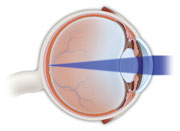Farsightedness is a refractive error, which means that the eye does not refract or bend the light properly and the images are not clearly focused. When there is farsightedness, distant objects are usually seen clearly, but the near ones are blurred.
People experience farsightedness in different ways. Some people may not have any problems with their vision, especially when they are young. Other people with considerable farsightedness may have blurred vision at any distance, near or far. This is an eye disorder related to the imaging approach, not an eye disease.
Causes of Hyperopia

When there is farsightedness, the eye is too short. Close objects are blurred because the images focus beyond the retina.
To make it possible for our eyes to see, light rays must be bent or refracted by the cornea and lens to focus and that’s how they are focused on the retina, the layer of photosensitive cells that covers the back of the eye. The retina receives the image formed by the rays of light and sends it to the brain through the optic nerve, which is actually a part of the brain.
Like myopia (bad vision from afar), farsightedness is usually hereditary. Most children are usually hyperopic, however, they do not experience blurred vision. By focusing or accommodating the image, children’s eyes can bend the rays of light and place them directly on the retina. As long as farsightedness is not too severe, hyperopic children will have a clear vision to see objects at a distance and up close. As the eye grows and lengthens, hyperopia decreases.
Symptoms of Hyperopia
Some signs and symptoms of farsightedness include having difficulty with close-up tasks such as reading, eye fatigue, squinting your eyes and having headaches.
Most children are hyperopic, however, they do not experience symptoms of blurred vision because their eyes are able to bend the rays of light to place them directly on the retina.
Diagnosis of Hyperopia
Jan. 17, 2012
Your ophthalmologist can diagnose farsightedness during a complete eye examination. He or she will determine if you have farsightedness by a standard vision examination, where you are asked to read the letters in a box placed at the other end of the room.
If the test shows that the vision is hyperopic, the doctor uses certain examination devices to know what is causing the farsightedness. By placing the glow of a special light in your eyes, a retinoscope is used to see how the light in the retina is reflected. As light reflects from inside the eye, the device can indicate if a person is myopic or hyperopic.
Your ophthalmologist will also use a phoropter, an instrument that measures the number of refractive errors you may have, and helps determine the best prescription to correct them.
Treatment of Hyperopia
Eyeglasses or contact lenses are the most common methods for correcting the symptoms of farsightedness. These help the reorientation of light rays on the retina, compensating for the shape of your eye. They can also help protect your eyes from harmful ultraviolet rays (UV). An ultraviolet ray repellent lens coating is at your disposal.
In other cases, people may choose to correct hyperopia with LASIK or another similar form of refractive surgery. These surgical procedures are used to correct or improve your vision by remodeling the cornea, or the front surface of the eye, effectively adjusting the focusing ability of the eye.
There is insufficient scientific evidence to suggest that eye exercises, vitamins, or pills can prevent or cure farsightedness.
There is no better method for correcting farsightedness. The most appropriate correction for you depends on your eyes and your lifestyle. Talk about your lifestyle with your eye doctor to decide what type of correction would be more effective for you.